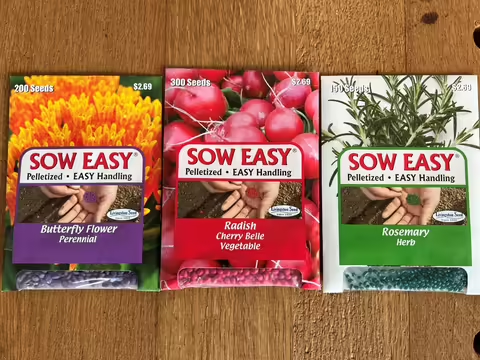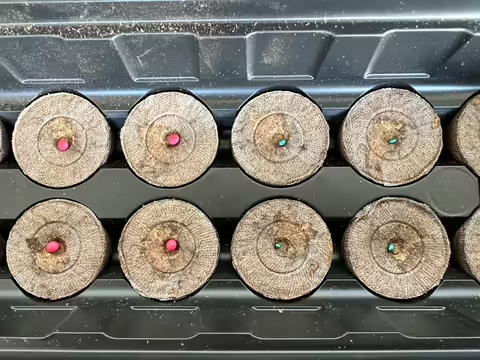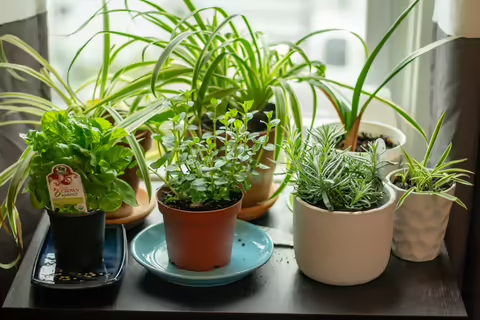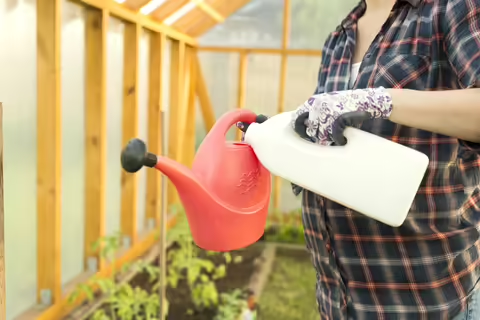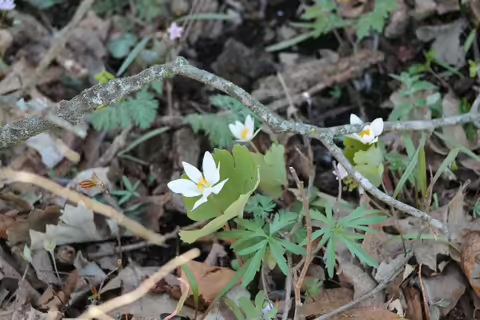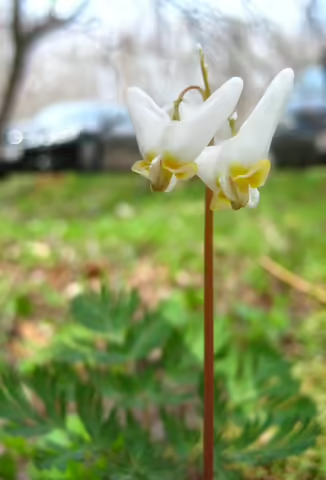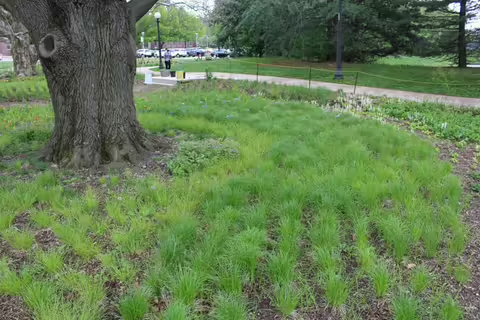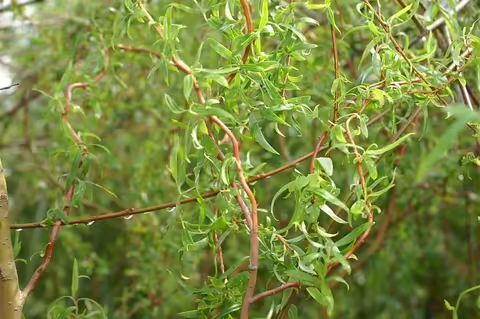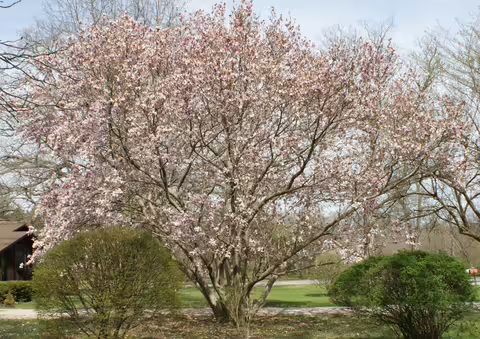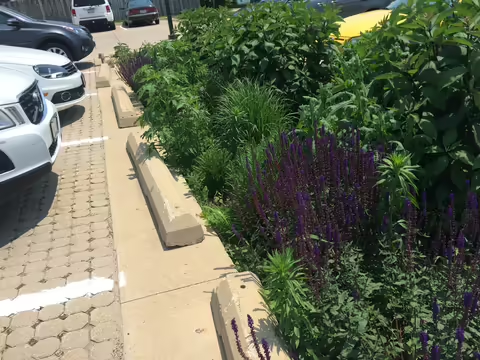Plant new fruit, vegetable, and flower varieties with confidence with 2022 All-America Selection Winners
By Horticulture Educator Bruce Black
Another Illinois winter has gone with the promise of spring to soon arrive. Garden catalogs have been arriving for months allowing gardeners to look forward to spring 2022 - the fresh air, energic wildlife, and the gardening. While many have already bought seeds and started to sow them, what if you’re just now thumbing through seed and plant catalogs looking for inspiration, warmth, and a new challenge?
Start by keeping good garden records from previous years to aid in the planning for the new spring. I always like to test a new plant or six, that is suited for USDA hardiness zone 5, which can sometimes be a challenge without a plan or a map.
After mapping out your existing perennials, think about what new plants could be added to your landscape and their space requirements. After covering this topic now for seven years, my starting place is the All-America Selections.
All-America Selections, AAS, is a non-profit organization that releases several trialed plants each year as AAS Winners. AAS tests new varieties every year at their private and public trial sites located around the United States and Canada. Currently, there are four trial locations in Illinois – three northern, and one central.
Independent judges, who are professional horticulturists in geographically diverse areas, evaluate trial entries against comparison plants. The results and observations are compiled, and winners are chosen. For the best plants suited to Illinois, look for Great Lakes winners or National winners on the AAS winners lists.
This year, there are 12 AAS Winners, 10 of which are suited for Illinois – six vegetables, one fruit, and three flowers.
National Vegetable Winners
- Eggplant Icicle F1, Solanum melongena var. Icicle F1: This is a white eggplant with fewer spines than other eggplants. The larger cylindrical fruits have fewer seeds. At 48 inches tall, it requires staking. It has 55 days to harvest from transplant. The plant spreads 28 inches.
- Lettuce Bauer, Lactuca sativa variety Bauer: Ideal for in-ground, containers, or raised beds. Uniform, compact, dense heads of dark green leaves. 58 days to harvest from seed and 34 days from transplant. Harvest at baby or full-sized leaves for enjoyment. An excellent candidate for controlled environments.
- Pepper Buffy F1, Capsicum frutescens variety Buffy F1: Good yielding, faster maturing, hot pepper with thick walls and 500,000 Scoville units. Upright, 28-inch plants with heat tolerance and ornamental value. It has 70 days to harvest from transplant.
- Pepper Dragonfly F1, Capsicum annuum variety Dragonfly F1: Purple, four-lobed, sweet bell peppers with thick walls. The purple color changes to red if it is left on the vine too long. Plant height is 24 inches to 36 inches. Each plant produces 40 peppers. It has 75 days to harvest from transplant.
- Tomato Purple Zebra F1, Solanum lycopersicum var. Purple Zebra F1: A sweet-leaning acidic tomato with disease resistance. It has green stripes on dark red thinner-skinned fruits. It has 80 to 85 days to harvest from transplant. Its upright growth habit requires staking. Each plant produces 150 to 200 tomatoes.
Regional (Heartland) Vegetable Winner
- Tomato Pink Delicious, Solanum lycopersicum variety Pink Delicious: A pink, early maturing, higher yielding, and beefsteak uniform tomato. Good disease resistance. Higher Brix (sugar) for a pink tomato. A 6-foot-tall upright climber with a 3-foot spread. It has 84 days to harvest from transplant.
Regional (Great Lakes) Vegetable Winner
- Watermelon Century Star F1, Citrullus lanatus variety Century Star F1: A 10-pound, round, seedless, spotted variety. Crisp melon with sweet flesh. Vines spread 9 feet to 11 feet. Bears two to three fruits per plant. It has 65 days to harvest from transplant and 75 days from seed.
Gold Medal Winners
- Begonia Viking™ Explorer Rose on Green F1, Begonia x hybrid variety Viking™ Explorer Rose on Green F1: An annual, trailing begonia with rose-colored flowers that is excellent for hanging baskets and containers. Heat, weather, and disease tolerant. Pollinator friendly and 50 days to flower from transplant.
- Petunia Bee’s Knees, Petunia x hybrid variety Bee’s Knees: This is the first petunia Gold Medal winner in 72 years. It has lush yellow, non-fading flowers on green leaves and needs little maintenance with a mounding and trailing habit. It is an annual flower that is heat and rain tolerant and pollinator friendly.
National Flower Winner
- Sunflower Concert Bell F1, Helianthus annuus L variety Concert Bell F1: Sturdy and durable, Concert Bell F1 has multiple clusters of 10 to 12 annual flowers. It is a uniform height at 5 feet to 6 feet. It is earlier to flower than other sunflowers. Direct seed for a great landscape attraction or for cut flowers.
Looking for something else to fill in your landscape and gardens? The All-America Selections website, all-americaselections.org, contains a list of all past vegetables and flowers winners since its founding in 1933.
For more information about gardening, check out the Illinois Extension Horticulture website at extension.illinois.edu/global/horticulture or their YouTube channel at go.illinois.edu/UniversityOfIllinoisExtensionHorticulture.
Gardener's Corner is a quarterly newsletter from the Illinois Extension team of horticulture experts. Each issue highlights best practices that will make your houseplants, landscape or garden shine in any season.
How will you grow? Join the Gardener’s Corner email list and get direct access to timely tips!
Pelleted seed gives gardeners a sown in advantage
By Horticulture Educator Mary Fischer
Download the Gardening with Pelleted Seed Infosheet
Have you noticed the windowed packets of seeds at garden centers with brightly colored “seeds”? These pelleted seeds are small or irregular seed that have a specialized inert coating applied to improve planting, spacing, and germination. Often the coating, which increases the weight and size of the seed, is colored which aids in planting several varieties of seed in one tray, a row in a garden, or a field.
While pelleted seed was originally developed for commercial production with a mechanical seeder. Then, seed companies began producing pelleted seed for vegetables and flowers and seeds are now available at local garden centers and big-box stores.
History
Pelleted seed has been used intermittently since WWI. The improved pelleted seed was introduced for cereal seeds in the 1930s by a British seed company, Germains. In the 1940s, the U.S. used several types of pelleted seed in reforestation studies. The 1960s saw large-scale use of pelletized seed by commercial growers primarily for its ease of use with mechanical planters and new seed coating technologies. In the 1970s, California banned the use of short-handled hoes, increasing the use of pelleted or coated seeds.
Benefits of Pelleted Seed
Today, pelleted seed has many positive benefits for commercial productions and home gardeners. The coating protects seed from birds, rodents, and a wide range of environmental conditions that often lead to replanting. It reduces loss from needing to thin plants.
Precise spacing requires less seed, and since the seed is coated and visible, less seed will be used saving gardeners money.
For large-scale producers, it is easier for specific applications like aerial dropping or mechanical seeders. There are nutrient benefits with increased oxygen availability. The coating allows for pre-inoculation of legume seeds. Since chemicals are applied to the seed and not the whole field, application is safer and there is a lower cost of agricultural chemicals.
One obstacle to widespread adoption of pelleted seed has been the ability of the coating to split open once it is hydrated allowing oxygenated moisture to reach the seed. New levels of coating densities for commercial growers has overcome that issue.
Meghan Shinn has two precautions when using pelleted seed in a March 1, 2020 article from Horticulture Magazine. First, the growing medium needs to remain consistently moist, but not soggy, after the seed is sown. Secondly, all the pelleted seed must be used in the season it is purchased. This should not be a problem with most home gardeners as seed packets contain smaller amounts of seed.
How to Use Pelleted Seed
Pelleted seed is very easy to use. The colored coating allows a home gardener to see the seed as it is planted, the seed spacing, and where it is planted before covering with soil. If a home gardener is starting seed in a tray for transplant later, pelleted seed makes it easier to identify the different types of seed as it is planted.
How to Make Seed Tape
Another method of planting pelleted seed is to make your own seed tape. This is quite easy to do using single-ply toilet paper and glue.
- Simply tear off a length of toilet paper to fit the garden plot. Fold it in half lengthwise and cut into two pieces. Fold each length in half longways and open.
- Following the recommended spacing on the seed packet, place small dots of glue at the appropriate distance to one side of the fold, then add a seed.
- Once the entire length has been planted, fold the other side over the seed side.
- This tape can be wrapped around an empty paper towel roll and labeled for later use.
- When ready to plant, prepare the garden bed, lay the tape on the bed, and cover it to the proper depth as directed on the seed packet.
Gardener's Corner is a quarterly newsletter from the Illinois Extension team of horticulture experts. Each issue highlights best practices that will make your houseplants, landscape or garden shine in any season.
How will you grow? Join the Gardener’s Corner email list and get direct access to timely tips!
Get growing with indoor kitchen garden
By Horticulture Educator Nicole Flowers-Kimmerle
Growing food is not limited to outdoors in the summer. With some planning, you can grow food indoors throughout the year.
Before starting an indoor kitchen garden, it is essential to think about what you want to gain by growing food indoors. You might wish to have herbs to give recipes a special touch or boost nutrition for added health benefits.
Keep in mind the amount of work you want to put into your indoor garden, schedules including your daily routine and time away, and whether your plants will be only indoors or transferred to outside during nice weather.
Light Needs
The limiting factor for growing plants indoors is light. Three aspects of light must be considered when planning to grow an indoor garden – light intensity, duration, and quality.
Most plants grown for food need intense, bright light. A south-facing window is a good location for natural light exposure for plants.
Many plants are sensitive to changes in the time they are exposed to light. Light duration affects their growth, flowering, and setting fruit. Supplemental light during the short days of winter will ensure the plants get light for the required time. Plants also need times of darkness. A timer is a helpful tool to help you deliver the proper duration of light to your plants.
Light quality refers to the color of the light. In general, blue-green light is required for plants to have healthy growth. Red-orange light is necessary for flowering and fruit. Sunlight has all the colors of light.
Supplemental light varies depending on the source. Fluorescent lights give off light in the blue spectrum. Incandescent light is in the red/orange spectrum and gives off heat. It is not essential to buy expensive lights for an indoor garden but to understand how to use light resources effectively.
Water, Air, Soil and Pollination
Providing the proper amount of water is critical for an indoor garden. Check the soil for moisture to determine when to water. It is best to keep the soil profile consistently moist. Too wet or too dry can cause stress to the plant.
Good air circulation around plants helps to prevent fungus and disease problems.
Sterile potting media is a good choice for an indoor kitchen garden. Start your garden without worrying about disease or insect pests. Choose media that drains well to help plants thrive.
Wind and insects pollinate food plants outdoors but are lacking in indoor spaces. Some plants such as tomatoes can be pollinated by shaking them to mimic the wind, while others such as strawberries need to have the pollen transferred by hand to mimic insects.
Indoor herb options:
- oregano
- Thyme
- Lemongrass
- Chives
- Mint
The first four thrive in bright light, but do not tolerate overwatering. Only water when the top of the soil is dry. Growth can be slow during the winter, so harvest leaves sparingly until new leaves form. Mint can tolerate less light and more water. Keep some on hand to add to teas or desserts.
Indoor fruit and vegetable options:
- Lettuce
- Microgreens
- Tomatoes
- Citrus trees
- Alpine strawberries
A variety of lettuce can be successfully grown indoors. Scatter seeds evenly across moist soil media and lightly cover. Lettuces thrive in cooler temperatures and need less light than other edible plants. Microgreens are packed with nutrition. These delicate plants are best grown indoors where environmental conditions can be controlled.
Patio varieties of tomatoes and citrus trees can be grown in pots with bright light and moist soil. Keep in mind that these plants will need some help with pollination for fruit to form.
Alpine strawberries can grow well in a bright, cool space out of direct light. For fruit, hand pollination is necessary.
There are so many options for growing an indoor kitchen garden. Try one or more to have fresh, nutrient-filled food all year long.
Gardener's Corner is a quarterly newsletter from the Illinois Extension team of horticulture experts. Each issue highlights best practices that will make your houseplants, landscape or garden shine in any season.
How will you grow? Join the Gardener’s Corner email list and get direct access to timely tips!
Flavor your meals with low-maintenance homegrown herbs
By Horticulture Educator Jennifer Fishburn
Culinary herbs are a favorite of many gardeners. They are easy to grow as they require little care, have few insect and disease problems, and generally prefer moderate fertility levels. In addition, they add fragrance and beauty to the garden. Many herbs such as lavender, sage, and purple basil, are very ornamental and combine nicely in flower or vegetable gardens.
Now is the time to plan what herbs you will plant this spring. First consider what herbs you use in food dishes, then consider which herb plants will add texture, color, and fragrance to your garden.
Seeds and plants can be mail ordered and most can be purchased locally. Herbs such as dill, cilantro, and basil are easy to grow from seed. Lavender, rosemary, sage, and thyme are easily grown from purchased plants.
Mint and oregano are easy to divide, so ask a fellow gardener for a start of their plant.
Herb care
Throughout the growing season, herbs do need some attention including weeding, watering, and harvesting. Weeding takes persistence. If planted in a garden, most established herb plants don’t need additional watering. However, when rainfall is less than 1 inch per week, additional moisture may be needed. The key is to avoid overwatering as herb plants do not like wet feet.
Harvesting Herbs
Harvesting of herbs can be done throughout the growing season. Throughout the summer, annual herbs grown for their leaves such as basil, summer savory, and sweet marjoram, should be cut back leaving approximately 6 inches of stem and leaves. Cut back the stem to just above a leaf or pair of leaves. Most annual leafy herbs don’t survive frost or freezing. So, if frost is predicted, remove as much of the plant as you desire for preserving.
Dill and cilantro are annual herbs grown for both leaves and seeds. For a continual supply of fresh leaves, reseed every two weeks. If growing for seeds allow the plant to mature before harvesting. Collect seed heads as they turn a light brown. Place seed heads upside down in a paper bag. Allow to dry for about two weeks and shake seeds off stems before removing stems from the bag.
Prune leafy perennial herbs such as sage, rosemary, thyme, and oregano by removing one-third of the top growth at a time. Avoid heavy prunings of perennial herbs after the beginning of September. In the fall, plants that will overwinter, need to start shutting down. Heavy pruning will promote new growth which keeps a plant actively growing.
Herbs are best used fresh, however, most can be dried or frozen for later use. Before preserving herbs, wash them to remove dirt and other particles.
Gardener's Corner is a quarterly newsletter from the Illinois Extension team of horticulture experts. Each issue highlights best practices that will make your houseplants, landscape or garden shine in any season.
How will you grow? Join the Gardener’s Corner email list and get direct access to timely tips!
Scale up your garden’s health with fish emulsion fertilizer
By Horticulture Educator Christopher Enroth
Over the years, there has been a growing demand for organic-based fertilizers to use in the garden and landscaping. There are of course ways to manufacture these organic fertilizers, but what if we could use a byproduct of the manufacture of a different product? It is an efficient use of our natural resources and perhaps even creates a sustainable source.
Byproduct fertlizer
This has given rise to many different types of organic fertilizers appearing on the market that are the “leftovers” of some other type of industry.
For instance, corn gluten meal is an organic fertilizer that is a byproduct of the corn milling industry. Milorganite is a hybridized trade name of an organic fertilizer. “Mil” means Milwaukee, “orga” shortened from organic, and “nite” for nitrogen. Though I was originally taught “nite” came from the term “night soil” which is human waste. Milorganite fertilizer is made of biosolids from treated sewer sludge from the Milwaukee Metropolitan Sewerage District.
What is Fish Emulsion Fertlizer?
And then there is fish emulsion. Fish emulsion is the leftover liquid from the fish meal and fish oil industry.
To get a picture of fish emulsion think back to or look up the Saturday Night Live video of Dan Aykroyd hawking his Super Bass-o-Matic ‘76. With the help of a blender, some water, and a dead fish, Aykroyd made a fish emulsion.
Of course, some other items go into processing fish emulsion, like straining out solid pieces and adjusting the pH so the product doesn’t spoil in the container, but it is for the most part liquified fish.
What the Research Says
There are many unverified claims on the magic of fish emulsion. Some will say to soak seeds in this product for better germination rates. Initial studies show this not to be true. Others note to use this as a foliar spray for plants to absorb nutrients directly into their leaf tissue for big yields. Again, studies of sweet peppers show no difference in yield when using fish emulsion foliar sprays.
Fish Emulsion is an Effective Fertlizer
Fish emulsion has been shown to be effective as a fertilizer. While nutrient ratios may vary, a typical fish emulsion may have nitrogen (N), phosphorus (P), and potassium (K) rates of 2-4-1 and the micronutrients calcium, magnesium, sulfur, chlorine, and sodium.
A possible benefit of fish emulsion, and many of the organic-based fertilizers, is that they offer protein to feed our soil microorganisms, which may help to build a more robust soil food web resulting in improved plant health for the long term.
Then, there is the issue of the odor.
A liquid fish emulsion smells, well like blended up fish. I now avoid using it on houseplants, after applying it once and booting the plants outside after a day of playing the game ‘Find the Smell!’
Outdoors the odor is of little consequence. However, the raccoons took a very keen interest in why I was hiding dead fish in my outside containers and proceeded to dig in each pot on my patio. While this is not established research, over time several people have called the Illinois Extension office about raccoons digging in pots. After investigation, there does seem to be a trend of fish emulsion fertilizer use and mischievous raccoons.
Gardener's Corner is a quarterly newsletter from the Illinois Extension team of horticulture experts. Each issue highlights best practices that will make your houseplants, landscape or garden shine in any season.
How will you grow? Join the Gardener’s Corner email list and get direct access to timely tips!
Early blooming spring ephemerals flowers welcome warmer weather
By Horticulture Educator Gemini Bhalsod
Spring ephemeral flowers are nature’s gems after winter. These short-lived beauties are wildflowers that grow in woodlands in the early spring before the leaves on deciduous trees are open. They are called spring ephemerals because they have a relatively short blooming time.
These seasonal plants grow, flower, and set seed relatively quickly. They are usually dormant by mid-summer when the leaves die back again. In your garden one moment and gone another.
Spring ephemerals complete most of their life cycle in the early spring before the trees and understory shrubs leaf out and take over most of the available light. These plants start growing roots in the fall and winter, to fully emerge above ground in the spring. This time of year is a tough time to be a growing plant – soil temperatures are low, the weather is unpredictable, and there are just a few pollinators foraging.
As temperatures increase and sunlight becomes less available in the late spring and summer, growth slows down, nutrients are stored underground, and the plants begin to die back.
There is some conflicting information and opinions out there as to whether spring ephemerals are just a special type of spring flower or if they are a spring bulb. One major difference, with a few exceptions, is that ephemeral foliage dies back in the early summer while the foliage of spring bulbs lasts longer.
How to Grow Spring Ephemerals
With the right location, gardeners can grow spring ephemerals in their yards. Since a lot of spring ephemerals can be slow to grow and spread, plant them in groups to have a sense of fullness.
Plant in high organic matter areas that mimic a woodland; no fertilizer is needed. Water only during establishment or in times of drought. Leaf die back is normal.
Many nurseries sell spring ephemerals these days due to their increased popularity. Planting seeds can be a less expensive, but slower approach and you’ll have to break the dormancy of the seed before it grows. Nurseries sell potted plants in the spring and fall. If it’s a little later in the spring, the above ground portion of the plant might look yellow, but the root mass is still alive.
Never collect plants in the wild as it is illegal, and can really disrupt natural habitat.
Plants bought online that are mailed, they will likely be dormant with bare roots. There will be no top growth and they are usually packed in moist packing material. Plant them right away.
- Skunk Cabbage, Symplocarpus foetidus, is one of the earliest spring ephemerals that emerges in February. There are tiny yellow flowers held on a spadix inside of a purple flower. The plant attracts carrion flies as pollinators. After it flowers, large smooth cabbage-like leaves develop.
- Dutchman’s Breeches, Dicentra cucullaria, is a distinct plant that flowers in April. It gets its common name because the individual blossoms resemble pants, or ‘breeches.’ Leaflets are feathery and fern-like and it is pollinated by bees.
- Jack-in-the-Pulpit, Arisaema triphyllum, has very distinctive flower and seeds. The outside of the flower could be green, or purple striped. After flowering in June, the flower turns into a cluster of green berries which are persistent until they ripen into a bright red in early fall for birds to eat.
- Virginia Bluebells, Mertensia virginica, appear in March. These plants are known for spreading into masses of flowers. Clusters of bell-shaped purplish flowers stand over the foliage and the plant quickly dies back after blooming.
- Mayapples, Podophyllum peltatum, grow in large dense colonies that spread through rhizomes. The large bowl-shaped white flower grows under the umbrella shaped, glossy leaves. It grows in part-to-full shade and blooms from April to May. They tolerate drier soil conditions and short periods of drought, especially when flowering is complete.
- Bloodroot, Sanguinaria canadensis, blooms are very fleeting, sometimes lasting only a few days. It has a vibrant white flower with green-lobed leaf at the base. The rhizomes have an orange-red color when cut. Leaves can stick around throughout the season.
Gardener's Corner is a quarterly newsletter from the Illinois Extension team of horticulture experts. Each issue highlights best practices that will make your houseplants, landscape or garden shine in any season.
How will you grow? Join the Gardener’s Corner email list and get direct access to timely tips!
Give caterpillars a chance with soft landings under trees
By Horticulture Educator Kelly Allsup
Trees are natural caretakers – their limbs provide shade and shelter, their seeds and leaves provide food, their roots filter water. Insect scientists have another skill to add to the list – a haven for caterpillars. Entomologists are asking gardeners, homeowners, and landscapers to stop mowing and instead add permanent plantings under tree canopies to help moths and butterfly caterpillars survive.
Biologist, pollinator conservationist, and award-winning author Heather Holm describes these plantings as soft landings for insects. Once the caterpillar of a moth or butterfly eats its fill of tree leaves, most of the time it drops to the ground to pupate. It may burrow into leaf litter or the ground.
However, most people leave grass under trees, which has to be mowed. This creates an ecological trap preventing butterflies and moths from reaching adulthood.
A soft landing is critical under certain trees such as oak, willow, cherry, pines, and poplars. These keystone species trees feed a lot of species of butterfly and moth caterpillars. According to famed entomologist and author Doug Tallamy, oak trees support 534 species of lepidoptera, the insect order containing butterflies and moths, and black cherry supports 456 species. One of Illinois’ most well-known moths, the Polyphemus moth, feeds on oak and black cherry trees.
Erin Garrett, Energy and Environmental Stewardship Extension educator, asks homeowners to picture the habitat around one of their trees.
“Is the lawn under that tree a safe space to be? No, it isn’t,” Garrett says. “With leaves raked up or mowed, and lawn grass mowed weekly, those caterpillars do not have a safe space to develop.”
These soft landings do more than prevent lawnmowers from running over pupating butterflies and moths, they also provide habitat for other beneficial insects such as bumblebees, fireflies, lacewings, and beetles.
To create a soft landing, first, figure out if your tree’s roots are sensitive to disturbance. We would never want to harm roots on a tree. Severing even one major root can cause the loss of 15% to 25% of the root system according to the International Society of Arboriculture. Those with sensitive trees should apply properly mulched rings.
If a soft landing is appropriate, smother grass with wet newspaper or mulch. Add compost 2 inches deep compost starting 18 inches from the trunk and ending at the dripline, or the overhead canopy, of the tree.
Use small plugs of groundcovers or seed mixed with small spring-flowering bulbs such as grape hyacinth, crocus, winter aconite, snow drops, or Siberian squill.
Although most bulbs thrive in full sun, it is a myth that you cannot grow spring-flowering bulbs in shady areas because bulbs have bloomed before trees fully leaf out.
Plants for dry shaded areas
These plants, which are available in flats as small plugs, are appropriate as a soft landing ground cover in dry shade.
Lamium has silver variegated leaves with showy purple, pink or white flowers that bloom from May to July. It grows 6 to 9 inches tall and has a 2- to 3-foot spread. When planting, it is best to space plugs 18- to 24 inches apart. This plant is resistant to deer munching.
Pachysandra is an evergreen of whorled glossy leaves that blooms white in April. This plant grows 6 to 12 inches high and spreads 12 inches. Leave plugs 12 inches apart. It will need to be thinned once it is well established to prevent disease. It is resistant to rabbit and deer.
Epimedium has compound heart-shaped leaves on wiry stems that turn red in the fall. It boasts attractive flowers of red or yellow in May. It grows 12- to 14 inches tall and spreads about 18 inches. It can be slow growing but is resistant to rabbit and deer.
Blue Sedge spreads quickly and combats weeds. The bluish-greenish foliage forms a nice mound and blooms mid-June to mid-July. This ground cover furthers contributing to the biodiversity by hosting skipper butterfly caterpillars and providing seed for birds.
Plants for wet shaded areas
Wild ginger is a native ground cover with a kidney shaped leaf that blooms in April at the base of the plant. When looking, you will find a purple cup-shaped flower that is usually covered by the foliage. It grows 6- to 12 inches tall and spreads 12 to 18 inches. It is resistant to deer.
Sweet Woodruff has a delicate leaf but is a mat-forming ground cover that blooms white in late spring. It grows 8 to 12 inches tall and spreads 12 to 18 inches. It has fragrant flowers and foliage that smells like fresh-cut hay when crushed. It can be planted under black walnut trees.
Gardener's Corner is a quarterly newsletter from the Illinois Extension team of horticulture experts. Each issue highlights best practices that will make your houseplants, landscape or garden shine in any season.
How will you grow? Join the Gardener’s Corner email list and get direct access to timely tips!
Grow curly willows for an artistic twist in the landscape, winter flower arrangements
By Horticulture Educator Christina Lueking
Willow trees are most well known for their long, draping branches that give them a refined and graceful appearance. That is unless it is a corkscrew willow.
The unique branching and twisting features of the Salix genus curly willow not only adds visual interest to the winter landscape but it can also be harvested and used for unique decorative arrangements says University of Illinois Extension horticulture educator Christina Lueking.
Curly willow has beautifully curled branches that have led to some crazy common names such as corkscrew willow, twisted willow, and snake willow.
Site Selection
Woody varieties generally prefer fertile, well-drained soil and full sun throughout the day. However, willows are a perfect fit for filter strips between annual crops or wet areas with their mature branches that are upright with a few sweeping younger branches that droop until they become more mature. These trees are easily propagated and can have a long lifespan as a sculptural element in the landscape or a garden bed.
The fall leaves turn a golden yellow color before dropping to show off the brilliantly colored burgundy or golden stems. Prune these stems to 3-foot-long sections and use the results in winter decorations.
Decorative Qualities
These sturdy bundles can be molded into round wreaths, heart-shaped designs, or even free flowing sculptures in vases with white lights. Have fun enhancing your décor or arrangements with this unique willow.
Harvest of branches can range from a few feet on shrubs to several feet on mature trees. Branches can be used as a fresh or dry product in floral arrangements. Remember to mold stems while they are pliable and bundle them with wire before they dry. It is harder to shape stems if they are completely dried.
Pests and Disease
Pests that like to feed on the leaves of the willow are aphids, spider mites, mealy bugs, lace bugs, caterpillars, willow leaf beetles. The willow borer drills into the trunks and creates tunnels and the adults emerge to feed on the tissue of the branches.
Scout willows to spot infestations that can be controlled by pruning the heavily infested areas and disposing of the cuttings. The areas can then be sprayed with neem oil or insecticidal soap.
Willow trees do have a couple of disease issues including crown gall and willow scab. But with scouting and mulching you can be proactive in controlling these issues.
For more information on tree care, connect with your local Illinois Extension county office at go.illinois.edu/ExtensionOffice.
Gardener's Corner is a quarterly newsletter from the Illinois Extension team of horticulture experts. Each issue highlights best practices that will make your houseplants, landscape or garden shine in any season.
How will you grow? Join the Gardener’s Corner email list and get direct access to timely tips!
Magnolia blooms, beetles are nature’s spring flower odd couple
By Horticulture Educator Ryan Pankau
Every spring, magnolia trees across the Midwestern landscape offer some of the most spectacular flowering displays of any woody plant. These beautiful ornamental trees, native to Asia, are some of the first landscape plants in our area to deliver such a showy display; truly one of the most endorsing signs that spring is finally here.
Most of Illinois’ native, deciduous trees are primarily wind-pollinated and many bloom even earlier than magnolias, although often unnoticed by many of us says University of Illinois Extension horticulture educator Ryan Pankau. Their strategy is to produce a lot of pollen in the hopes that wind dispersion will spread their genes far and wide. Wind pollinated species do not need a showy display to attract pollinating animals or human attention. They typically lack aroma and nectar which, along with color, are the primary means plants use to attract pollinators to their flowers.
Since most of our native trees, like oak, ash, and maple, evolved flowers for wind pollination, they are largely unnoticed during flowering.
Their smaller, low-key flowers are not designed to be colorful or attractive, but rather to allow tons of pollen to freely float away on the wind. Their pollen producing structures, called anthers, are often loosely attached, and hang down to dangle in the wind.
Magnolias evolved a different strategy for pollination. Their flowers are quite showy, produce nectar, and have fragrance, all in the effort to attract insects. They invest more energy in these insect-attracting traits than pollen production, generating much less pollen per flower than their wind-pollinated cousins.
The interesting twist with magnolias is that their genus Magnoliais quite ancient, evolving very early in the plant family tree, earlier than our native flowering trees. They are considered to be among the oldest of the flowering plants.
At the time of their evolution, many common pollinators we think of today, such as bees, butterflies, and moths had not evolved yet. As a result, magnolias developed flowers for pollination by beetles and flies, which were the primary insect pollinators 100 million years ago.
Magnolia flowers are relatively simple when compared to other, more specialized flowers. Pollen structures are arranged so that insects searching for a nectar reward will haphazardly bump into them and subsequently spread pollen as they amble from flower to flower.
Flightless beetles were the primary constituents of magnolia flowers millions of years ago as they evolved and are often considered “dumb pollinators.” These poor insects get a bad rap because they cannot perform more advanced behaviors of butterflies and other pollinators that evolved later as the plant-pollinator relationship became more complex. Butterflies and other “smarter” pollinators can perform advanced tasks, such as extraordinary feats of flower manipulation, to harvest pollen.
The lowly beetle, which receives a ton of credit for the early development of magnolia flowers, is left to dumbly wander from flower to flower. The process of co-evolution between flowering plants and insects is considered one of the most intricate multi-species evolutionary processes on earth. When plants evolved flowers, it was a game-changer for plant reproduction. So, there is no reason to totally discount beetles as “dumb” since magnolia flowers would not be possible without these grunts of the pollinator world.
Consequently, magnolias evolved to accommodate their “less educated” pollinators with some specially tailored adaptations. Beetle mouthparts are made primarily for chewing, not pollen collection from delicate flower parts. Thus, other plant parts are often consumed in the process of harvesting pollen or nectar from the flowers.
Magnolia flowers have leathery, thick leaves along with seeds that are well protected to handle this kind of sloppiness.
Magnolias and their beetle friends are certainly an odd couple in the plant and insect world. However, their relationship has worked out wonderfully to produce some of our most exquisite flowering ornamental trees.
Gardener's Corner is a quarterly newsletter from the Illinois Extension team of horticulture experts. Each issue highlights best practices that will make your houseplants, landscape or garden shine in any season.
How will you grow? Join the Gardener’s Corner email list and get direct access to timely tips!
Slow stormwater, prevent floods with rain friendly landscaping
By Horticulture Educator Emily Swihart
Life does not exist without water. Gardens don’t grow without water. But what happens when there is too much of a good thing? Or when that good thing is mismanaged and becomes a misfortune. Or when there are prolonged periods of drought?
The tale of stormwater is more frequently a story of feast or famine. Managing this resource onsite can have ripple effects downstream and throughout the watershed.
Rain gardens, bioswales, permeable pavement, are all methods to slow stormwater and prevent floods.
How Water Naturally Moves
Before Illinois was settled, it was covered in diverse ecosystems of prairies, woodlands, and wetlands. These features were connected through a vast network of river valleys and stream corridors. When rain fell, nearly all the water was absorbed into the soil where it was available for plant use or slowly percolated into groundwater.
Water that travels through the soil profile does so at a slower rate than water flowing on the surface. Water is cooled and filtered while traveling through the ground on its way to being discharged in a natural spring. The water that did exit the site as surface runoff, did so slowly, having to weave in and out of the stems of plant materials, minimizing the potential for erosion and flash flooding.
As human populations grew, large portions of natural ecosystems were converted into impermeable surfaced areas of rooftops, roads, and parking lots. Stormwater that falls on these areas cannot infiltrate into the soil, nor does it leisurely travel downslope. Stormwater on impermeable surfaces is quickly whisked away, traditionally toward a storm sewer.
Build with Green Infrastructure
In large storm events, communities with combined storm and sanitary sewer systems can become overwhelmed and flood.
Managing stormwater by channeling it can help minimize local flooding or water ponding but can compound challenges downstream. Furthermore, stormwater that is removed is no longer available during dry weather.
“Green infrastructure” systems more effectively manage stormwater and can help reduce runoff and capture rainwater onsite or close to where it falls. Many of these systems are beautiful and can easily be incorporated into existing landscapes. Multiple systems can be utilized for increased impact.
- Rain gardens are a depression or shallow basin planted with native species to capture runoff from an identified source and hold it temporarily until the water slowly filters out. Most native plant species have vast root systems that penetrate deep into the soil profile and encourage water infiltration. Properly designed and installed rain gardens do not hold water for long periods of time. Rain gardens can be beautifully designed and can incorporate steppingstones for access, sculptures for aesthetic appeal, or a wide variety of plant forms for a personalized effect.
- Bioswales, or stormwater swales, are similar to rain gardens. These shallow channels move water offsite. By design, the low slope and intentionally selected plant material move water slowly over the surface, increasing infiltration and filtering out contaminants prior to reaching a stream or storm sewer.
- Permeable pavement or pavers allow water to move through the hardscape into a gravel layer beneath. Water can be stored in the gravel until it is evaporated back into the atmosphere, it can move through the subsurface slowly before discharging into a storm sewer or can be removed from the site through a pipe into a rain garden or bioswale.
- Rain barrels and cisterns are containers that capture and store stormwater. Retained water is available for use during dry periods, typically to water landscape plants.
Incorporating green infrastructure into a home landscape is an excellent way to enhance aesthetic appeal while helping to better manage water resources. For more information, get in touch with horticulture staff at your local Illinois Extension office at go.illinois.edu/ExtensionOffice.
Gardener's Corner is a quarterly newsletter from the Illinois Extension team of horticulture experts. Each issue highlights best practices that will make your houseplants, landscape or garden shine in any season.
How will you grow? Join the Gardener’s Corner email list and get direct access to timely tips!

